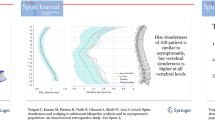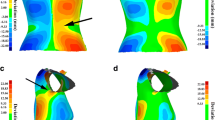Abstract
Objective
Adolescent idiopathic scoliosis is the most prevalent type of scoliosis, and its consequences on the human torso have not been deeply studied. In spite of being a 3D condition, clinical management is circumscribed to 2D images among health-care professionals. GMM is a well-recognized tool in the study of 3D shape and symmetry.
Methods
Twenty-four subjects with AIS and 24 controls were subjected to surface scan. Digitization and shape data were extracted and submitted to GMM analysis. 3D shape and asymmetry were correlated with Cobb angle in subjects with X-ray availability. Comparisons of mean shapes were done between each group and its symmetric average shape and between each group at two states: initial and 6 months after.
Results
AIS and controls show similar areas of asymmetry, being significantly higher in quantity in AIS (PD = 0.045; PD 0.037; p < 0.001). Significant correlation was observed between Cobb angle and Procrustes asymmetry (r = 0.38; p = 0.01) as happened with 3D shape (r = 0.11; p < 0.001). No significant changes were observed in the 3D shape of both groups 6 months after (AIS, p = 0.51; control, p = 0.304).
Conclusion
The greater asymmetry observed in AIS was expectable, but the similarity of areas of asymmetry in both groups made us suspect of directional asymmetry in the human torso that could explain the high prevalence of right scoliosis observed in nature. The shape of the torso and the asymmetry should be considered as variables to study in AIS due to its correlation with Cobb angle. Progression of the deformities was not observed in our study, maybe due to short-term follow-up.




Similar content being viewed by others
References
Hresko MT, Talwalkar V, Schwend R, AAOS, SRS, POSNA (2016) Early detection of idiopathic scoliosis in adolescents. J Bone Joint Surg Am 98(16):e67
Clin J, Aubin CE, Labelle H (2007) Virtual prototyping of a brace design for the correction of scoliotic deformities. Med Biol Eng Comput 45(5):467–473
Negrini S, Aulisa AG, Aulisa L, Circo AB, de Mauroy JC, Durmala J, Grivas TB, Knott P, Kotwicki T, Maruyama T, Minozzi S, O’Brien JP, Papadopoulos D, Rigo M, Rivard CH, Romano M, Wynne JH, Villagrasa M, Weiss HR, Zaina F (2012) SOSORT guidelines: orthopaedic and rehabilitation treatment of idiopathic scoliosis during growth. Scoliosis 7(1):3
Rogala EJ, Drummond DS, Gurr J (1978) Scoliosis: incidence and natural history. A prospective epidemiological study. J Bone Joint Surg 60:173–176
Gacitúaa MV, González MC, Sanz C, Mullic V, Goddardd P, Rolóne E, Castellof P, Hiebrag M, Pappollah R, Maenza R (2016) Adolescent idiopathic scoliosis. Arch Argent Pediatr 114(6):585–594
Trobisch P, Suess O, Schwab F (2010) Idiopathic scoliosis. Dtsch Arztebl Int 107(49):875–884
Bonagamba GH, Coelho DM, Oliveira AS (2010) Inter and intra-rater reliability of the scoliometer. Rev Bras Fisioter 14(5):432–438
Ho C, Parent EC, Watkins E, Moreau MJ, Hedden D, El-Rich M, Adeeb S (2015) Asymmetry assessment using surface topography in healthy adolescents. Symmetry 7(3):1436–1454
Grant CA, Johnston M, Adam CJ, Little JP (2019) Accuracy of 3D surface scanners for clinical torso and spinal deformity assessment. Med Eng Phys 63:63–71
Komeili A, Westover L, Parent EC, El-Rich M, Adeeb S (2015) Monitoring for idiopathic scoliosis curve progression using surface topography asymmetry analysis of the torso in adolescents. Spine J 15(4):743–751
Hill S, Franco-Sepulveda E, Komeili A, Trovato A, Parent E, Hill D, Lou E, Adeeb S (2014) Assessing asymmetry using reflection and rotoinversion in biomedical engineering applications. Proc Inst Mech Eng H 228(5):523–529
Ghaneei M, Komeili A, Li Y, Parent EC, Adeeb S (2018) 3D markerless asymmetry analysis in the management of adolescent idiopathic scoliosis. BMC Musculoskelet Disord 19(1):385
Ghaneei M, Ekyalimpa R, Westover L, Parent EC, Adeeb S (2019) Customized k-nearest neighbourhood analysis in the management of adolescent idiopathic scoliosis using 3D markerless asymmetry analysis. Comput Methods Biomech Biomed Eng 22(7):696–705
Klingenberg CP (2015) Analyzing fluctuating asymmetry with geometric morphometrics: concepts, methods, and applications. Symmetry 7(2):843–934
Bookstein FL (1991) Morphometric tools for landmark data: geometry and biology. Cambridge University Press, Cambridge, p 435
Koo TK, Li MY (2016) A guideline of selecting and reporting intraclass correlation coefficients for reliability research. J Chiropr Med 15(2):155–163
Bastir M, García-Martínez D, Torres-Tamayo N, Palancar CA, Fernández-Pérez FJ, Riesco-López A, Osborne-Márquez P, Ávila M, López-Gallo P (2019) Workflows in a Virtual Morphology Lab: 3D scanning, measuring, and printing. J Anthropol Sci 97:1–28
Rohlf FJ, Slice D (1990) Extensions of the procrustes method for the optimal superposition of landmarks. Syst Zool 39:40–59
Zelditch ML, Swiderski DL, Sheets HD, Fink WL (2004) Geometric morphometrics for biologists. Elsevier Academic Press, New York, pp 105–128
Hammer Ø (2017) PAST PAleontologicalSTatistics: Version 315. Natural History Museum, University of Oslo, Oslo
Du Q, Zhou X, Negrini S, Chen N, Yang X, Liang J, Sun K (2016) Scoliosis epidemiology is not similar all over the world: a study from a scoliosis school screening on Chongming Island (China). BMC Musculoskelet Disord 17:303
Goldberg CJ, Dowling FE, Fogarty EE (1994) Left thoracic scoliosis—why so different? Spine 19:1385–1389
Arienti C, Buraschi R, Donzelli S, Zaina F, Pollet J, Negrini S (2019) Trunk asymmetry is associated with dominance preference: results from a cross-sectional study of 1029 children. Braz J Phys Ther 23(4):324–328
De Silva NK (2018) Breast development and disorders in the adolescent female. Best Pract Res Clin Obstet Gynaecol 48:40–50
Chulani VL, Gordon LP (2014) Adolescent growth and development. Prim Care 41(3):465–487
Marty-Poumarat C, Scattin L, Marpeau M, Garreau de Loubresse C, Aegerter P (2007) Natural history of progressive adult scoliosis. Spine (Phila Pa 1976) 32(11):1227–1234
Courvoisier A, Drevelle X, Vialle R, Dubousset J, Skalli W (2013) 3D analysis of brace treatment in idiopathic scoliosis. Eur Spine J 22(11):2449–2455
Dunn J, Henrikson NB, Morrison CC, Blasi PR, Nguyen M, Lin JS (2018) Screening for adolescent idiopathic scoliosis: evidence report and systematic review for the US preventive services task force. JAMA 319(2):173–187
Bunnell WP (1986) The natural history of idiopathic scoliosis before skeletal maturity. Spine (Phila Pa 1976) 11(8):773–776
Acknowledgements
Funding was provided by Ministerio de Economía y Competitividad, Spain (Grant No. CGL2015-63648-P).
Author information
Authors and Affiliations
Corresponding author
Ethics declarations
Conflict of interest
The authors declare that they have no conflict of interest.
Additional information
Publisher's Note
Springer Nature remains neutral with regard to jurisdictional claims in published maps and institutional affiliations.
Electronic supplementary material
Below is the link to the electronic supplementary material.
Supplementary Figure 1
Posterior (a), right lateral (b), anterior (c) and left lateral (d) view of template showing the 22 landmarks (red points), the 16 curve semilandmarks (blue points) and the 122 surface semilandmarks (green points). (JPEG 53 kb)
Rights and permissions
About this article
Cite this article
González-Ruiz, J.M., Pérez-Núñez, M.I., García-Alfaro, M.D. et al. Geometric morphometrics of adolescent idiopathic scoliosis: a prospective observational study. Eur Spine J 30, 612–619 (2021). https://doi.org/10.1007/s00586-020-06583-5
Received:
Revised:
Accepted:
Published:
Issue Date:
DOI: https://doi.org/10.1007/s00586-020-06583-5




